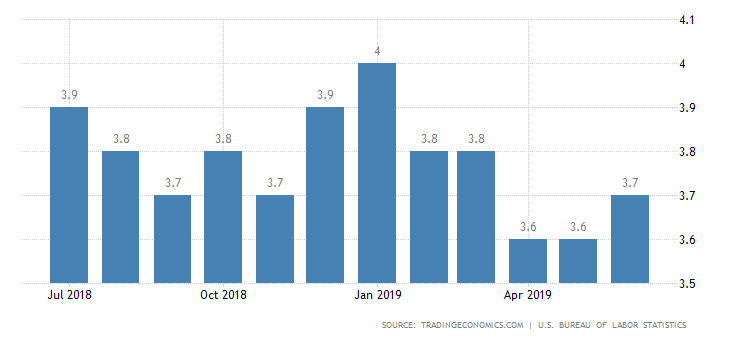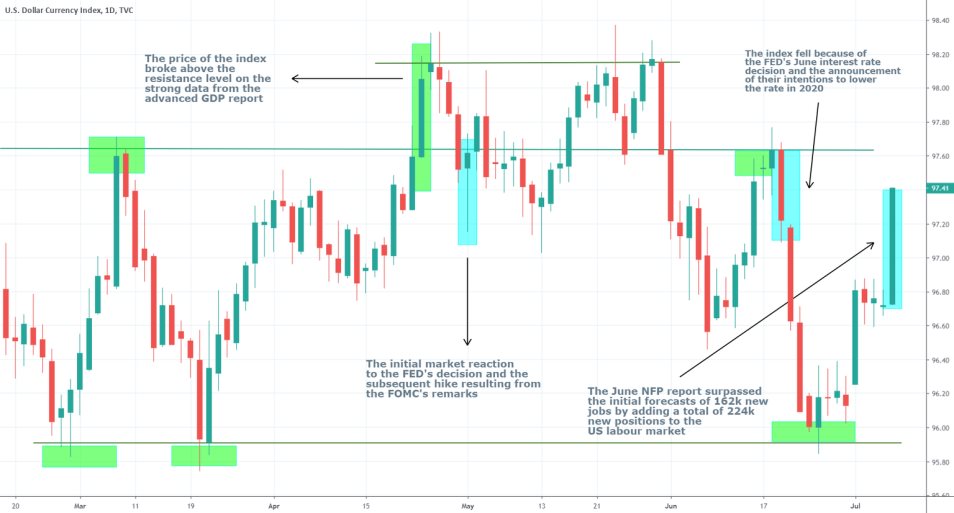
The US non-farm payroll employment rose with 224 000 newly added jobs in June, which surpassed the initial forecasts for 162 000 new jobs, but the underlying unemployment rate rose to 3.7 per cent.
The most significant job gains were registered in the professional and business services industry, as well as the health care industry. However, the overall unemployment rate, as perceived by demographics characteristics, demonstrates different conclusions about the state of the US labour market. According to household survey data:
“Both the unemployment rate, at 3.7 per cent, and the number of unemployed persons, at 6.0 million, changed little in June.” [source]
According to the establishment survey data:
“Total nonfarm payroll employment increased by 224 000 in June. Employment growth has averaged 172 000 per month thus far this year, compared with an average monthly gain of 223 000 in 2018.”
The apparent success of the American industry-performance across multiple sectors is what keeps investors upbeat, and also caused the initial market reaction to the release of the report, which measured a sizable increase of the value of the USD, as the US dollar currency index spiked with 0.60 per cent immediately after the release of the report.
The performance of the various American industries in June managed to surpass both the average employment growth throughout 2019, as well as the employment growth that had been registered throughout the previous year. Following these results, the initial market reaction was to perceive the June NFP as being overall positive.
However, it should also be noted that with the added revisions of the final results observed during April and May, the general perspective of the labour market is also marginally shifted.
“The change in total nonfarm payroll employment for April was revised down from +224 000 to + 216 000, and the change for May was revised down from + 75 000 to +72 000. With these revisions, employment gains in April and May combined were 11 000 less than previously reported.”
Despite the 0.1 per cent increase in the total unemployment rate, the US labour market remains resilient, and the aggregate employment remains close to full employment and within the target range of the FED. However, the risk is not entirely removed, and Jerome Powell and the FOMC would still have to consider how to sustain the current state of affairs, even at the cost of possible interest rate cuts if needed.

The monetary policy committee would most likely remain vigilant and observe the future developments in the US labour market, in addition to the underlying changes in the inflation rate.
Meanwhile, the US dollar currency index has gained momentum following the release of the NFP report and is on track to continue compensating for most of the losses that were registered in June.

Trendsharks Premium
Gold is undergoing a correction, as investors take profits to offset losses from falling stock prices, impacting their margins. However, we anticipate a renewed wave of [...]
The Swiss stock market index is mirroring its global counterparts, such as Germany 40 and US100, experiencing a sharp decline following the announcement of new [...]
We’re analyzing the weekly chart to grasp the broader market trend. Over the past three years, the US30 index has surged by 17,000 points, often resembling a nearly straight [...]
Over the past week, the DAX has experienced a sharp decline, plunging by an astonishing 3,400 points. This downward movement is not isolated, as its international counterparts, such as the UK100 and US100, are also facing significant [...]
EURUSD recently formed a double top at 1.0930, signaling a potential trend reversal, and has since begun a correction. After a 600-pip rally since early March, a pullback at this stage is both expected and healthy. Given these conditions, we are placing a [...]
Since early March, EURJPY has surged nearly 1,000 pips, providing us with several excellent trading opportunities. However, as the rally matures, many early buyers are beginning to take profits, leading to a noticeable slowdown in the uptrend. On Friday, the pair formed a [...]
The AUDJPY currency pair continues to be dominated by bullish momentum, as multiple golden cross patterns reaffirm the strength of the ongoing uptrend. Despite this, we are witnessing a much-needed [...]
The EURAUD currency pair appears to be undergoing a trend reversal, signaling a potential shift in market direction. A notable technical development is the formation of a Death Cross on the chart, a widely recognized bearish indicator that typically suggests a [...]
After securing an impressive 200-pip profit last week, the EURJPY currency pair is now undergoing a southward correction, retracing some of its recent gains. Despite this temporary pullback, the Golden Cross remains intact, reinforcing our view that the overall trend continues to be [...]
The appearance of a Golden Cross in Silver strengthens our analysis that the metal is currently in a strong uptrend, indicating further bullish momentum in the market. This technical pattern, where the short-term moving average crosses above the [...]
This trade presents a considerable level of risk and can be classified as an opportunistic move based on recent price action. The GBPUSD currency pair has experienced a substantial bullish rally, surging by nearly 500 pips in a strong upward movement. However, after this extended period of appreciation, the pair is showing signs of a potential [...]
The anticipated Death Cross on the SMI20 appears to be failing as price finds strong support at the 23% Fibonacci retracement level. After testing this area, the index has shown bullish strength, printing several large green candles, signaling an increase in [...]
A Golden Cross has just appeared on the USDJPY chart, signaling a potential bullish move. This technical pattern occurs when the 20 period moving average crosses above the 60 period moving average, a widely recognized indication of increasing [...]
After 2 months of a down trend, we finally see some indications of price recovery for Oil. The golden cross, a historic buy signal, supports this [...]
For the past month, the German DAX40 has experienced a remarkable 10% surge, reflecting strong bullish momentum. Despite ongoing market volatility and frequent pullbacks, every dip continues to attract fresh buyers, reinforcing the [...]
Oil continues its downward trajectory, despite occasional pullbacks. The overall trend remains bearish, reinforced by multiple Death Cross patterns, a classic sell signal indicating further weakness. Adding to this bearish outlook, the critical [...]
Over the past few days, gold has experienced a sharp decline of more than $100. This downturn can be attributed in part to traders securing profits to manage their margins, which are under strain due to the significant drop in major indices. Currently, gold has fallen below the [...]
The NASDAQ 100 index is showing strong bullish momentum, as evidenced by the formation of a Golden Cross on the chart. This classic buy signal occurs when the short moving average crosses above the long term moving average, suggesting that upward momentum is [...]
The EURAUD currency pair has encountered a significant resistance level, failing to break above the critical 61% Fibonacci retracement level. This suggests that bullish momentum is weakening, reinforcing the case for a potential downward move. Given this technical setup, we favor entering a [...]
The UK100 is experiencing a remarkable rally! Over the past few weeks, the British stock market index has surged nearly 800 points. Each minor dip has attracted more buyers, fueling the bullish momentum. However, since last week, we’ve observed a slight [...]




















